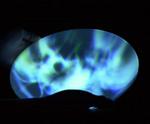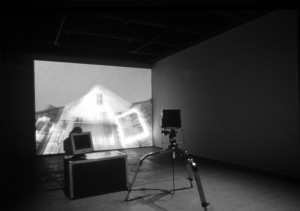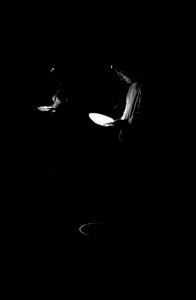Artists and scientists, in different but equally fundamental ways, seek out patterns in the natural world and sensitise others to them. Scientists, like artists, validate their work aesthetically, and both make intellectual choices that are governed by a sense of concordance with nature. Science and art together are needed for full description of the world. The belief that they are dissonant and incompatible distorts and misrepresents them both. (Frank Oppenheimer, 1972 in The Museum as Laboratory, The Exploratorium).

Lynette Wallworth, Hold, 2001, Art Gallery of NSW, installation view. Photographr Diana Panuccio. Image courtesy of the artist.
This article is an attempt to contextualise an artistic practice that occupies spaces between and within two disciplines of thought: art and science. Here, a body of creative work has been emerging in contemporary culture that finds its foundations in scientific concepts and discoveries, shares similar processes of inquiry, offers new perspectives and approaches, and questions the ethical, moral and perceptual dimensions inherent in modern advances in technology and science knowledge.
Art and science practice can be about artists engaging with science concepts and facets of natural phenomena. Their ideas reflect a fascination with form, pattern, spontaneity, complexity, aesthetics and forces in nature; developing new ways to bring this into the common ground of human experience. These artists need not necessarily work with the resources of a science research environment to explore their ideas. They can work with an individual practitioner or level of expertise.
Joyce Hinterding’s work explores and creates sensory experiences and environments within and between phenomena that is usually a medium of study reserved for scientists. “When considering the phases of matter- solids, liquids, vapours and the fourth, plasma- it is not a question of succession that interests me, but varying forms of co-existence and exchange that capture my imagination.” (ConVerge: where art and science meet, 2002 Adelaide Biennial of Australian Art catalogue essay, p.44)
John Tonkin’s early computer animations Air, water 1-3 series (1989) represent motion studies of air and water. John interprets phenomena such as gravity, elasticity and aerodynamics in a virtual space by translating mathematical modelling into computer programming.
Ben Blakebrough is currently developing the installation The Winged Self that shows the developmental processes of creating work based in a scientific arena not usually explored by artists. Ben has been researching the field of VTOL (Vertical Take-off and Landing) since 1997 and aims to combine the various theories of VTOL flight into a single unifying installation. (Synapse database, http://www.synapse.net.au)

Adam Donovan, Heteodyning Cage, 2002, Institute of Modern Art, installation view. (Image courtesy of the artist)
Art and science practice is also about artists engaging with a more formal research environment. Here artists can be part of creative ‘clusters’ engaging in interdisciplinary work practices with scientists, electrical engineers, economists and social sciences. Artists can bring different perceptions and approaches to research questions and research methods – they perhaps use the tools and tests developed for solving problems in different and enlightening ways. In these environments artists often show us phenomena that we have failed to see before in a way that often compels others to explore and understand aspects further.
Queensland artist, Adam Donovan’s work is an example. Adam is intensely interested in the physical characteristics of sound, its movement through space or ‘focussed acoustics’. This led him to a four-month collaboration with the Maritime Operations Division of the Defence, Science and Technology Organisation. Here he worked extensively with ultrasound as part of their sonar technology laboratory. New extensions of his own practice where possible through this opportunity, “…our collaboration aimed at proving previous claims about the device we were building (parametric arrays)…. However, in the process, I successfully destroyed three prototype arrays and needed to completely rethink the engineering of the acoustic lens.”
And for the science organisation: Adam’s concept of sound projection from multiple sources and spatial sensitivity to listeners is novel… This kind of artist-scientist fusion of ideas stimulates innovation and certainly has useful spin-offs for us. I favour such activities because they encourage defence scientists to think “outside the box”. (Dr Nandapogal, DSTO) .
Art and science practice can be about artists exploring the models and mediums of representation and interpretation of science. Here artists can extend and inform scientific visualization processes. This brings new opportunities to explore new public interfaces, extending our audiences in both the arts and sciences.

Lynette Wallworth, Hold, 2001, Art Gallery of NSW, installation view. Photographer Diana Panuccio. (Image courtesy of the artist)
Artists can present us with ideas with an immediacy unobtainable by science. Art can help us see, feel, hear and even conceptualise the world. Artists are expert perceivers. They render a representation of experience whose vindications lies in its resonance with the experience of others. In this way, artists have the opportunity to influence the relationships science has with its own audience and wider community. This practice also brings new audiences to the worlds of art.
Isabelle Delmotte’s Epileptograph: The Internal Journey (1995) provides us with a sensitivity and perceptive realisation of frontal lobe epilepsy. The artist has digitised and manipulated medical resonance images of her own brain taken during seizures. These new insights have now been integrated into research as powerful tools of analysis.
Lynette Wallworth’s 2001 two-part installation Hold, “…explores the intimacy and immensity of natural phenomena removed from scales of reference. Each shows a different way of viewing, where the visitor is positioned above the viewing device, gazing down into an array of exceptionally vast and incredibly minute images from astronomical bodies to microscopic marine algae”.
So what is this world of science we are collaborating with? Science can be described as a process of inquiry to build an understanding about nature. It is a creative practice – a process and way of thinking, of building models that help us interpret and understand our world. Contemporary science has moved on from the traditional Western scientific values. The obsession with prediction and control has been replaced by a fascination with the complexities and paradoxes inherent in natural systems.
Contemporary science’s quest for knowledge can be interpreted within these basic elements: Matter. Life. The Mind.
These ‘pillars’ are fundamental questions for artists as well. Scientific achievements of the twentieth century have unravelled the components underlying these elements in barely one generation: the splitting of the nucleus of the atom, the decoding of the nucleus of the cell, and the development of the electronic computer. In addition, three revolutions have taken place in the search for new knowledges:
* The quantum revolution: taking us beyond Newtonian physics to understanding matter from tiny subatomic quarks to giant supernova in outer space
* The biomolecular revolution; allowing us the ability to read and manipulate the genetic code of life
* The computer revolution; giving us the internet, information technologies and the ability to create minute intelligent systems
Artists are responding to these revolutions that have become our key drivers to social, cultural and economic change in our communities. Within these discoveries, and devised applications, there is a need for a social, cultural, even humanitarian response to the issues these advances pose. Artists can respond by pursuing the ethical and moral implications of their work- using it as stimulus for discussion.
In the growing field of ‘bio-art’ projects, artists investigate the connections between artwork and living organisms by working with genetic engineering tools and bacteria. Adelaide’s Experimental Art Foundation’s most recent project, Art of the Biotech Era brings together ‘leading national and international artists and theorists to explore biotechnology and genomics and discuss the influence of this techno-scientific change in society, the ethical implications of genetic engineering, and the concept of aesthetics in biotech arts’.
Scientists are also responding to these challenges. Many now recognise future discoveries could lie in the cross-fertilisation of areas of science. The discoveries in one field will fertilise discoveries in another. Perhaps we are moving from a period of reductionism and specialisation to one of synergy. There is a growing interest in the science community (and perhaps recognition of the potential) for working with the cultural industries and artistic pursuits.
Art and science practice is also about opening up the science institution, breaking down the barriers that protect the worlds of specialisation-making research accessible. This could also be said of our art institutions.
This practice is also about making our knowledges more accessible – it embraces an enormous potential to explore new ideas and discoveries, new modes of artistic expression and new processes – for both the arts and the sciences.
Linda Cooper
Linda Cooper, freelance art, science and technology consultant, has been working with ANAT on the development of an Art and Science Policy. In the following articles Linda discusses the collaboration of art and science and the work of Australian artists who are engaging with this expanding field of practice. Linda also provides some history on ANAT’s Art and Science initiatives and the Synapse program.
 This work is licensed under a Creative Commons Attribution-NonCommercial-ShareAlike 3.0 Australia.
This work is licensed under a Creative Commons Attribution-NonCommercial-ShareAlike 3.0 Australia.






